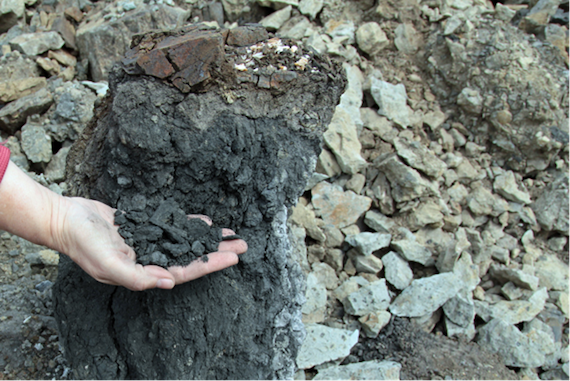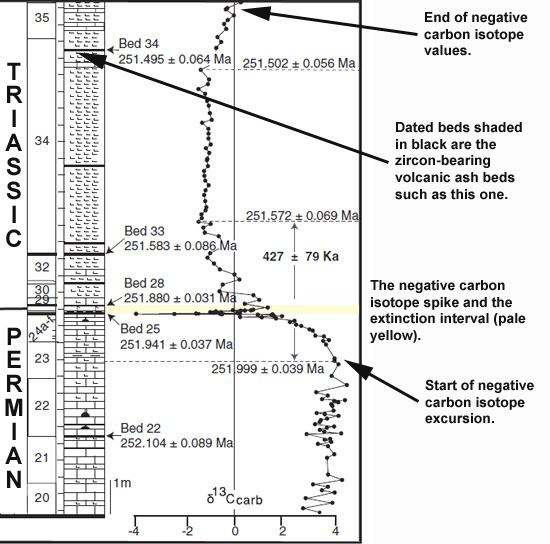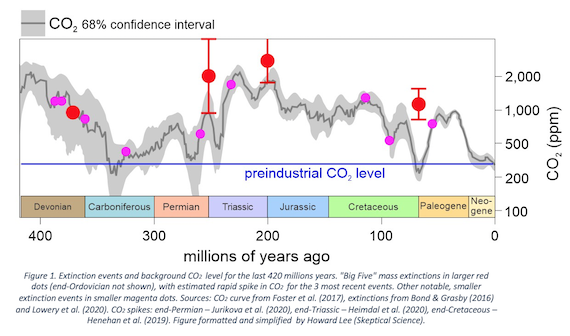Can animals and plants adapt to global warming?
What the science says...
| Select a level... |
 Basic
Basic
|
 Intermediate
Intermediate
|
 Advanced
Advanced
| ||||
|
Human-caused climate change is occurring too rapidly for species to be able to adapt. Plants and animals are currently dying off at a rate that is 100 to 1000 times faster than the average rate of extinction over geological timescales. Because of this, there is mounting evidence that we are heading towards a mass extinction event. |
|||||||
Animals and plants can adapt
[C]orals, trees, birds, mammals, and butterflies are adapting well to the routine reality of changing climate." (source: Hudson Institute)
The biggest mass extinction events in Earth’s geological history were driven by rapid environmental and climatic changes, occurring too quickly and widely for many species to be able to adapt to them. Figure 1 shows prior extinction events and atmospheric CO2 concentration over the last 420 million years, since the start of the Devonian period of geological time. Each coloured circle denotes an extinction event, with the most significant ones in red and the lesser extinction events in pink.
Most mass-extinctions have been linked to immense magmatic events, called Large Igneous Province (LIP) eruptions (Bond & Wignall 2014). No human has witnessed such an eruption, for they only occur every few tens of millions of years. Just as well: the Siberian Traps LIP produced at least three million cubic kilometres of products. In contrast, the May 1980 Mount St Helens eruption, impressive as it was, produced just 2.79 cubic km.
LIP events can inject billions of metric tonnes of carbon dioxide (CO2) and sulfur dioxide (SO2) into the atmosphere. But some are far more deadly than others. To find out why that's the case, we will look at one of the big ones. The eruptions took place at the end of the Permian Period, in what is now Siberia. The Siberian Traps is its name.
At the same time that the Siberian Traps eruptions were taking place, there occurred the largest mass extinction in the last 500 million years of Earth history, known as the “Great Dying”. With more than ninety percent of all species wiped out, it was by far the worst crisis for multicellular life, among the many disasters that have occurred through geological time. The extinction was global. It affected almost all animals and plants in almost all environmental settings. It was accompanied by a dramatic perturbation to the global carbon cycle, involving the injection of enough carbon dioxide to the atmosphere to more than triple pre-existing levels. There exist multiple lines of geological evidence for multiple environmental problems on multiple fronts. Rapid global warming, acidic rainfall, ozone layer damage, soil erosion, algal blooms, ocean acidification and anoxia: all took a dramatic toll on life on land and in the seas. An idea of the severity of this set of events can be visualised by considering that the aftermath was marked by a coal-gap lasting for ten million years. Coal-forming ecosystems simply did not exist, anywhere on Earth, for that time.
It is important to record that recent research has found that, although the Siberian Traps eruptions waxed and waned over a few million years, the extinction itself took place over a much shorter time-span. More importantly, that time-span, about 60,000 years in length, took place after the most voluminous stage of lava-extrusion, which had no great affect on biodiversity apart from in the immediate district. For reasons still imperfectly understood, just prior to the extinction the magma, instead of erupting at the surface, started to intrude the rocks through which it was passing, deep beneath the ground, to form perhaps the greatest complex of sills anywhere on Earth - a sill being a flat-lying intrusive sheet of igneous rock anything from centimetres to over a kilometre in thickness.

Fig. 2: an end-Permian smoking gun? One of countless masses of part-combusted coal enclosed by basalt of the Siberian Traps. Photo: Scott Simper, courtesy of Lindy Elkins-Tanton.
The big problem with that intrusive activity was the very nature of the rocks that were pervasively invaded by the magma, which forced its way through the accumulated strata of a large sedimentary basin, representing hundreds of millions of years of geological time. Within that sequence of sedimentary rocks was an abundance of coal seams, oil and gas deposits, black shales, evaporites (stuff like rock-salt or gypsum) and limestones, much of which got well and truly cooked during the intrusive activity. We have solid evidence (fig.2) for that critical interaction between magma and coal etc through field observations (Elkins-Tanton et al. 2020). That cooking drove off volatile compounds in vast quantities, including water, carbon dioxide, methane, ammonia, chlorine, sulfur and so on.
Intrusive activity associated with the Siberian Traps has now been accurately dated and has been found to coincide with the extinction (Burgess et al. 2017 and references therein). Its commencement is also marked by a massive anomaly in the carbon isotope record. That record is based on the fact that carbon has two stable isotopes, these being carbon 12 (six protons and six neutrons per atom) and carbon 13 (with one extra neutron). Carbon 12 is the super-abundant isotope while carbon 13 is rare, with the average ratio of their planetary abundance being 99:1. However, different carbon sources, for example Earth's mantle and biosphere, have different ratios of carbon 12 and carbon 13. These specific ratios are termed ‘isotopic fingerprints’. They are determined using the high-precision analysis that is available with modern mass spectrometers. Carbon sources that are richer in carbon 13 are termed ‘heavy’, whereas those depleted in carbon 13 are said to be ‘light’.
Notably, the biosphere carbon isotope fingerprint is especially light. The reason is that plants preferentially take up carbon 12 during photosynthesis, so their biomass is relatively depleted in carbon 13. Many animals eat plants and thus the resulting isotope ratio shift, in favour of light carbon 12, is spread onwards, up though the food chain. When the plants and the other participants in that food chain die and decay, the light carbon is released to the atmosphere as carbon dioxide and other gases. Alternately, if the biomass is buried and ends up preserved in the geological record, for example as coal, those rocks will carry that light carbon isotope fingerprint. If the coal is then burned, its light carbon will end up in the atmosphere.
Since there is a constant exchange of carbon dioxide between the atmosphere and the oceans, the light carbon isotope fingerprint then makes its way into seawater. Because carbon-bearing sedimentary rocks such as limestones have a chemistry that reflects the seawater composition at the time of their deposition, they too will carry that light carbon isotopic fingerprint. So any unusual perturbation to the carbon cycle soon gets spread around the system, where it is preserved for posterity in the rocks, just waiting for a geologist with their hammer and sample-bag.

Fig. 3: the type section of the Permian-Triassic boundary in southern China, showing the dated ash-beds, the extinction interval and the carbon isotope record from the time including the dramatic, negative spike at the onset of the extinction. After Burgess et al. 2014.
The carbon isotope anomaly associated with the Siberian Traps LIP represents a huge light carbon spike (“excursion”) in the isotopic record (fig. 3). It has been calculated that to create such a spike, between ten trillion and one hundred trillion tons of carbon dioxide had to have been released to the atmosphere over an estimated 2,000 to 18,000 years. That's a CO2 emission-rate of 5000 to 500 billion tonnes per century. Our current carbon dioxide emissions, by the way, are in excess of 3,000 billion tons per century.
Other pollutants likely had roles in the end-Permian mass extinction too, but the lesson is very simple. If you inflict massive physical and chemical stresses on ecosystems, as we are in many parts of the world, then more and more will fail and things start going extinct.
Adaptation becomes more and more difficult when the pollution is everywhere. Food chains start to break down and eventually disintegrate, species with a limited range of foods tend to be affected first and it is only the most adaptable life-forms with the widest range of tolerances that get through the crisis.
Last updated on 29 May 2023 by John Mason. View Archives































 Arguments
Arguments










































Climate Myth...